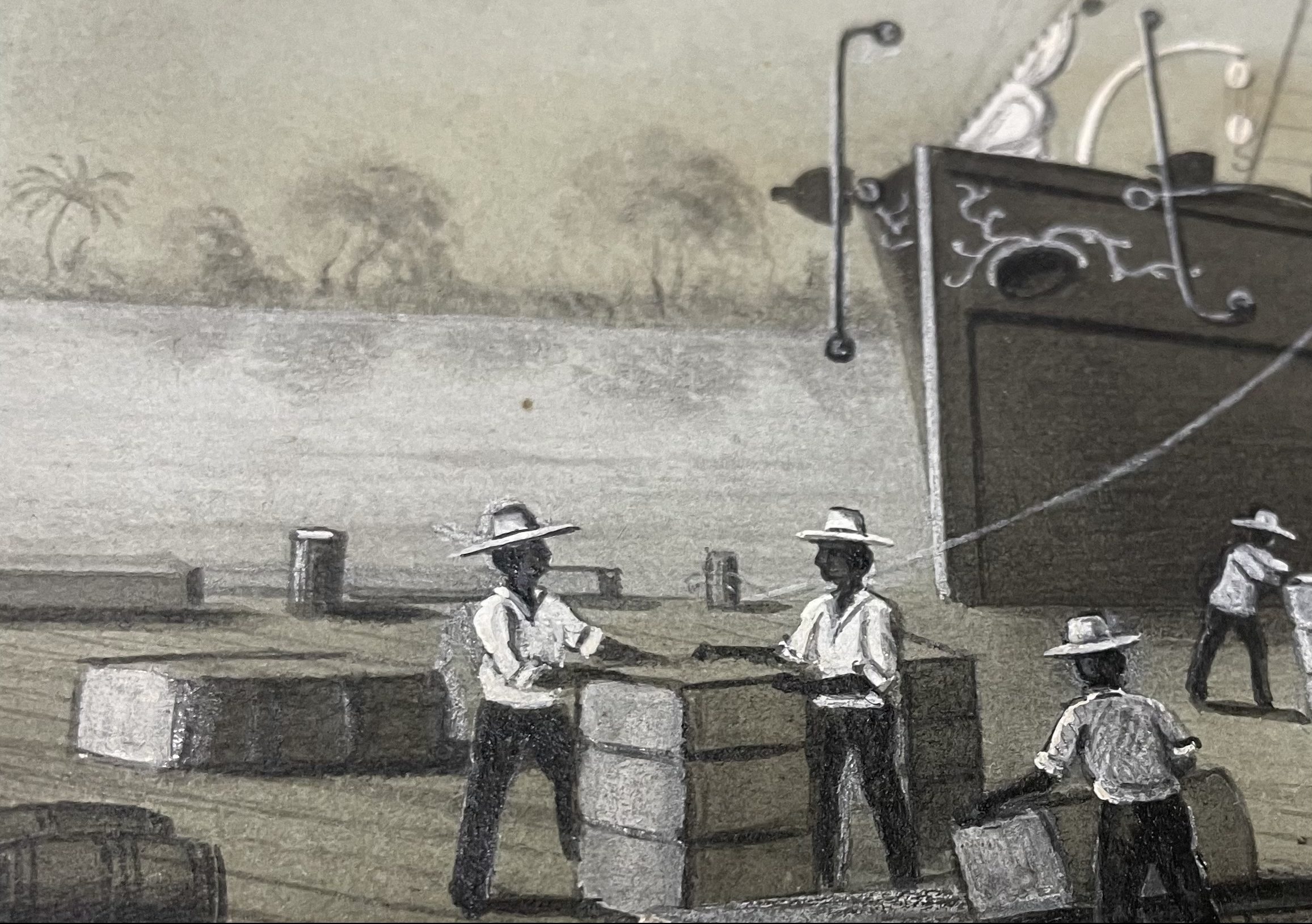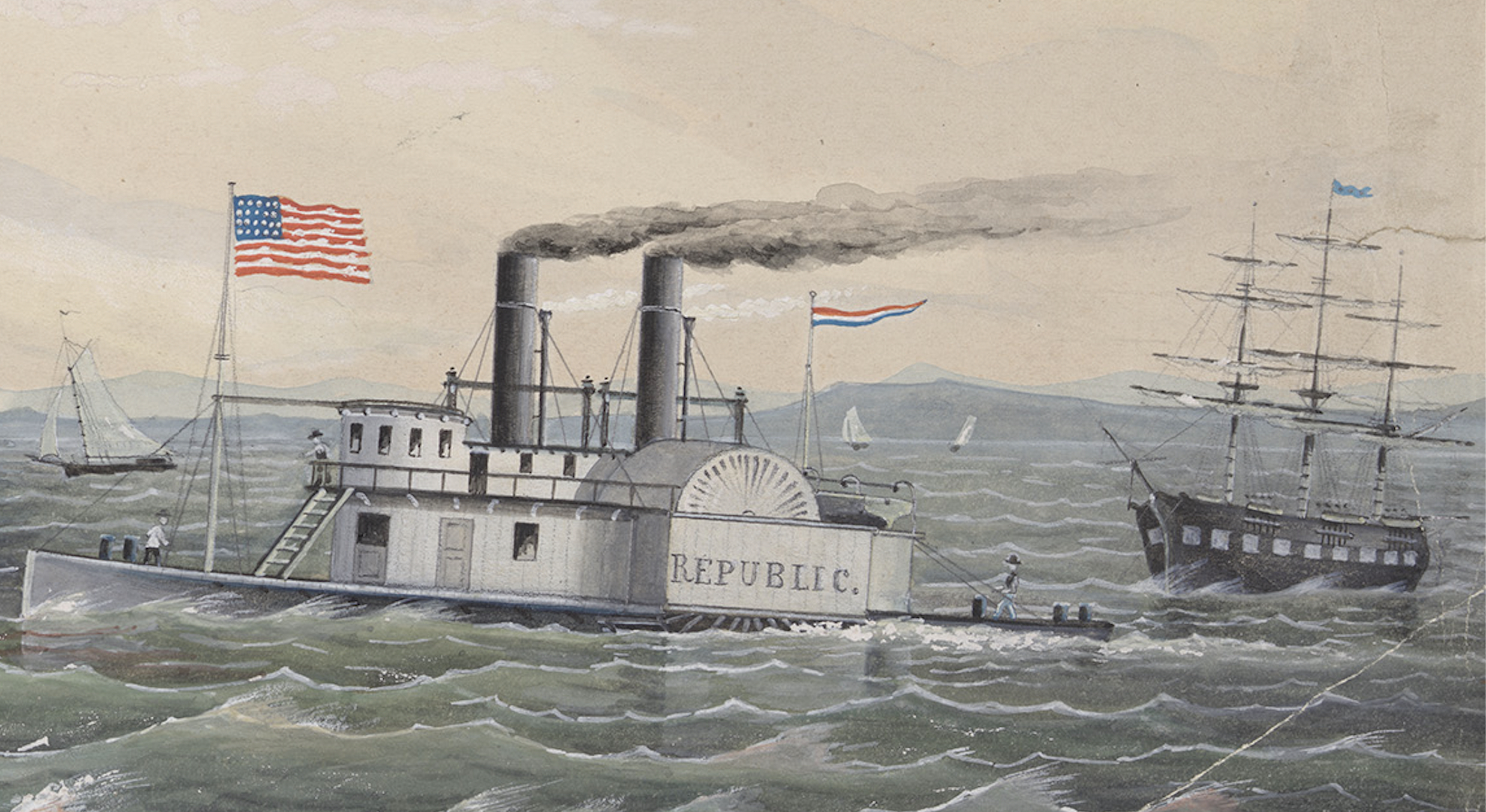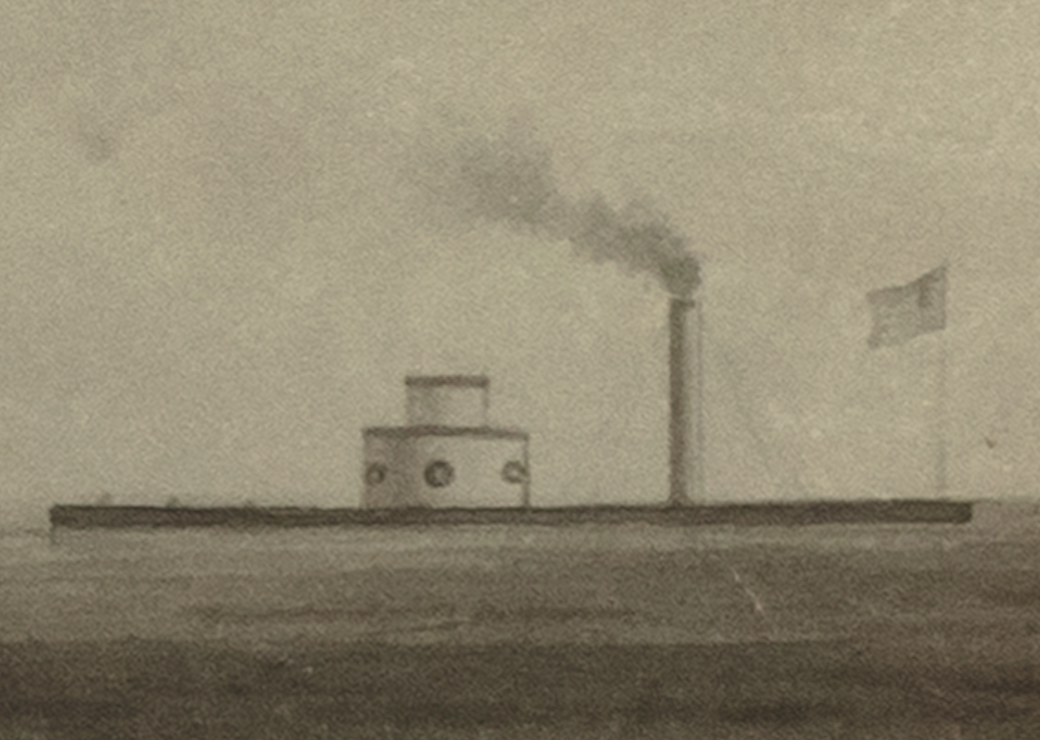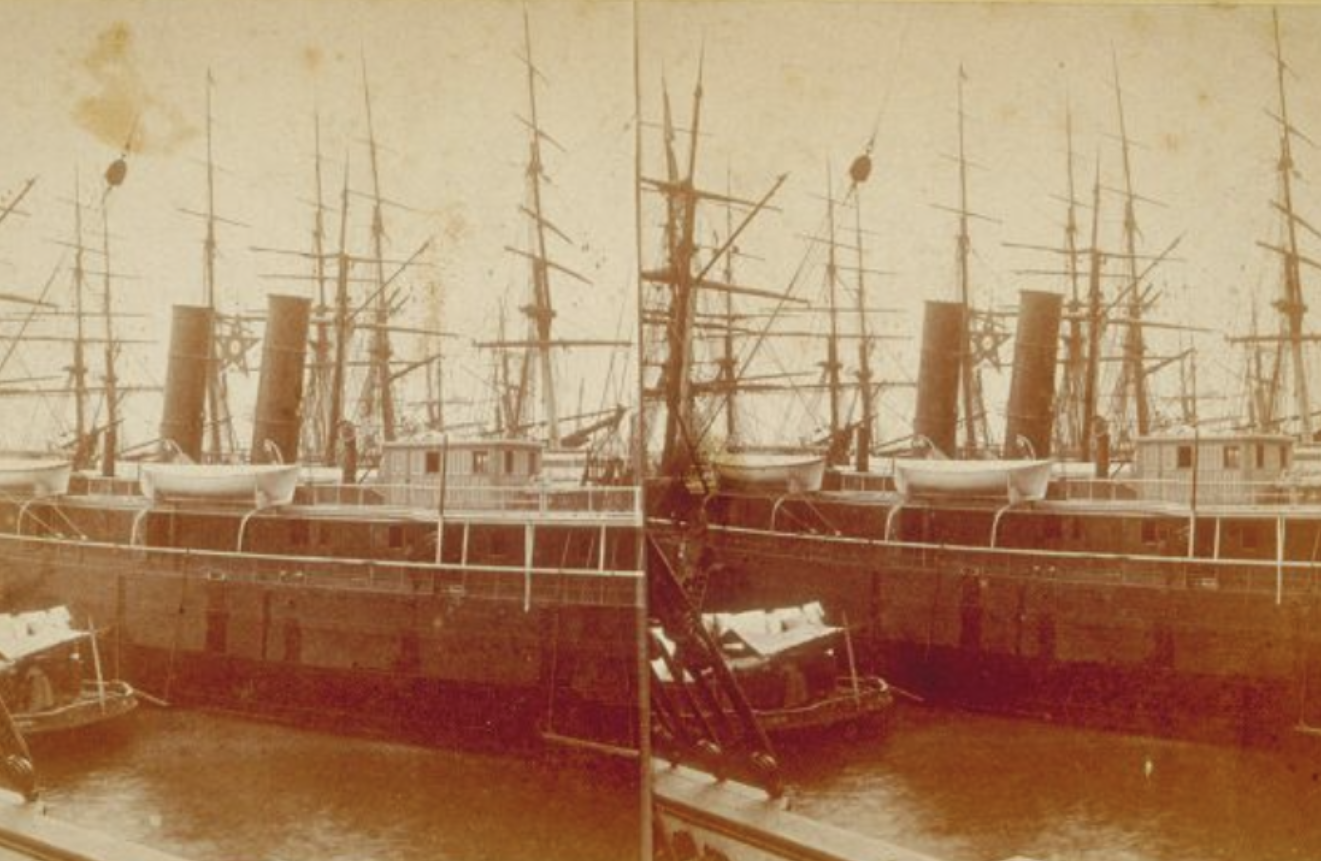Global Trade
While early small steamships fully replaced mast and sail with steam engine and paddlewheel, shipbuilders were hesitant to apply the same thinking for larger vessels destined for open water. Throughout the nineteenth century, and even into the twentieth century, larger merchant and passenger watercraft carried both sails and a steam engine. Lange painted one such vessel, probably in the 1880s, the City of Dallas, which was built by S. Gildersleeve & Son in Portland, Connecticut in 1872. Its construction was commissioned by C.H. Mallory & Co. to transport passengers and cargo along their shipping line that ran between New York City, Key West, and Galveston.
Edward Lange (1846-1912), Steam Ship City of Dallas of the Mallory Line, ca. 1881, Watercolor on paper, 9.5625 x 6.1875 in., The Mariners' Museum and Park, 1951.0761.000001
 The setting of the City of Dallas suggests a tropical or subtropical climate. Faint pencilmarks in the background to the left suggest palm trees growing across the water. The garb of the dockworkers or stevedores likewise suggests warm weather. This raises interesting questions about how Lange came to make this picture. Did he travel south with the vessel, or are these visual indicators imagined to suggest the context of the ship's work? In either case, the owners of the vessel likely commissioned this painting to hang in a company office.
The setting of the City of Dallas suggests a tropical or subtropical climate. Faint pencilmarks in the background to the left suggest palm trees growing across the water. The garb of the dockworkers or stevedores likewise suggests warm weather. This raises interesting questions about how Lange came to make this picture. Did he travel south with the vessel, or are these visual indicators imagined to suggest the context of the ship's work? In either case, the owners of the vessel likely commissioned this painting to hang in a company office.
Detail, Edward Lange, Steam Ship City of Dallas of the Mallory Line, ca. 1881
In comparison to Lange's depiction, this steroscopic photograph shows the City of Dallas moored along the wharves in New York City's East River. A New York Times article relates a fire that erupted on this vessel on February 19, 1878. Despite the best efforts of twelve fire engines, five fire trucks, and one fire boat, it burned and sank while docked at Pier No. 20 on the East River. Its cargo of oranges and cotton bales, recently transported from Fernandina, Florida, was completely lost in the blaze, though the ship was repaired and relaunched within the year.
J.W. & J. S. Moulton, Mallory Texas Line steamer, probably CITY OF DALLAS, at East River wharf, New York, Mystic Seaport Museum, 1978.244.32
Also painted by Lange, the City of New York was built the year after the City of Dallas, in 1873, by John Englis & Sons of Greenpoint, NY. It was one of several cargo and passenger vessels owned and operated by F. Alexandre & Sons, another New York-based steamship company. The business encountered profitable success for over a decade, transporting mail between New York City, Havana, and ports along the Mexican Gulf Coast. Pictured heading to sea on the left side of the paper, Lange chose to paint the City of New York utilizing both its steam and sail power in tandem.
Edward Lange (1846-1912), City of New York, 1876, Watercolor and gouache on paper, 8.9375 x 14.75 in., The Mariners' Museum and Park, 1941.0001.000001
 As the City of New York slashes diagonally out to sea, another pair of boats make their way to the foreground. The side-wheel tug, Republic, steams towards the foreground. It tows a ship with furled sails against the wind, as though to provide a counterpoint to the more capable, modern design of the City of New York. Other nineteenth-century artists commented on the advent of steam engines, notably J.M.W. Turner's The Fighting Temeraire, which details a tug hauling one of the last, great, oaken man o' wars of the British Royal Navy to a shipbreaking yard.
As the City of New York slashes diagonally out to sea, another pair of boats make their way to the foreground. The side-wheel tug, Republic, steams towards the foreground. It tows a ship with furled sails against the wind, as though to provide a counterpoint to the more capable, modern design of the City of New York. Other nineteenth-century artists commented on the advent of steam engines, notably J.M.W. Turner's The Fighting Temeraire, which details a tug hauling one of the last, great, oaken man o' wars of the British Royal Navy to a shipbreaking yard.

(above) Detail, Edward Lange, City of New York, 1876
The onset of the American Civil War brought about a domestic race in new naval technology. It was only then that shipbuilders began constructing large, mastless warships powered solely by their steam engines. A monitor-style warship in the background of Lange's painting of two warships sports a gun turret and smokestack mounted on the deck where masts otherwise would have been.
(right) Detail, Edward Lange, Sail and Steam-Powered Warship (Vandalia), 1881
Edward Lange (1846-1912), Sail and Steam-Powered Warship (Vandalia), 1881, Watercolor and gouache on paper, 12.875 x 18.875 in., Huntington Historical Society, 2013.2
Painted in 1881, this scene of warships off of Long Island gives a sense of how different generations of naval technology shared the waters around New York City. The main vessel in this scene is thought to be the Vandalia, a sloop-of-war the US Navy launched in 1876 that patrolled the eastern seaboard of the United States in the early 1880s. A newspaper article from September of 1881 related that the Vandalia traveled nearly twelve thousand nautical miles in the previous nine months, stopping at fifty-one ports in the Caribbean and along the Atlantic coastline of the United States. Several decades after Lange painted the Vandalia, shipwrights phased masted sail ships out entirely in favor of designs powered solely by steam engines.





![[Sail and Steam-Powered Warship] or [Vandalia], Huntington Historical Society, 2013.2_cropped.jpg [Sail and Steam-Powered Warship] or [Vandalia], Huntington Historical Society, 2013.2_cropped.jpg](https://d1y502jg6fpugt.cloudfront.net/61413/archive/fullsize/e8126169b55aba42ed3e4838764aa254.jpg?Expires=1715817600&Signature=n-6Phej7X59nsZSCnaAbAYem7sfWYIFvhhyNb%7Ejot6-PWN1MstFF%7E2thhqAHEeq6Rdc2pOobY5VOvA7iDrEYEL9C-zmxrHENUQ5XFueD7XWmDO70MDGCJXO%7EJxsVbyPi-x4lQE8txDC9woikApx7XQaCUmdT45zVX%7EQ5%7ENCLvr0RP6zd-y6X3b1i1-rNpNHOLCoYx3Xn2IGPsYKEAxlMv8Mpnqxcuql0cSjcrCLS3Uth0eNVAXv9GmixXcodBWNML2uIrjq0Y8CJ3UkffoQu6ZBmsPgMGm2EjK2MJBXMCP7FjwuAW14oA%7E8qC4KBo5DZK82YWXAVUhZzrjjoXpe3hQ__&Key-Pair-Id=K6UGZS9ZTDSZM)